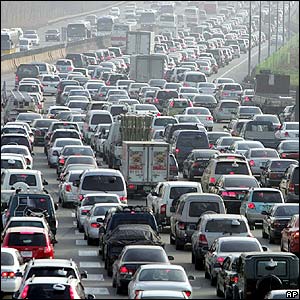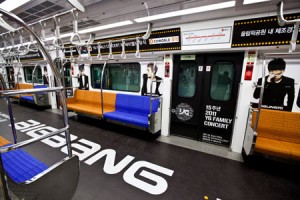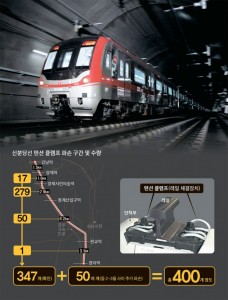By Winston Chang
The Korean Government’s implementation of the “Two Million Home Construction Plan” resulted in the creation of five new towns, one of which is known as Bundang. Bundang is now the largest district in the city of Seongnam, and sits 25 kilometers (approximately 15 miles) from Seoul. Its close proximity has invited new modes of transportation that have been instrumental to the development of Bundang and its relationship with center city Seoul.
Before the Korean Government’s large-scale plan to develop Seoul’s surrounding cities, Bundang was an empty agricultural area filled with farmlands of rice paddies. However, in 1989, The Korea Land Corporation decided to expand housing in these areas and create a “suburb” for center city Seoul. The process faced much protest and demonstration from the local residents, but after much negotiation, was completed in 1996. Today, the area is influential as one of the wealthiest areas in Metropolitan Seoul, stemming many businesses locally, as well playing a major role in expanding its economy into center Seoul. (Lee 2005).

“A Tangled Web » War On Motorists.” A Tangled Web » War On Motorists. N.p., n.d. Web. 16 Dec. 2013.
Example of traffic congestion for commuters to Seoul
With the development of Seoul’s suburb, transportation to and from the center city was an important demand. Bundang today has many modes of public transportation. The variety of transportation methods has in fact encouraged the idea of sprawl into Seoul’s suburb, allowing people to reside outside of the busy city of Seoul and commute to work in the center city. Seoul suffers greatly from traffic congestion problems, containing over 3 million cars, which counts for 17 percent of automobiles nationwide. This comes with many other environmental factors, with carbon monoxide accounting for 73.6 percent of the pollutant emissions in Korea (World Health Organization). Although public transportation is advanced within Seoul, in order for a commutable suburb to rise, a more efficient method of transportation was needed.
One of the most well-known projects in transportation improvement was the construction of the Shin-Bundang subway line. This construction began in 2005, planning to connect from Gangnam (Seoul’s wealthiest district) to Jeongja, a neighborhood in the Bundang district. The construction of the Shin Bundang line has gone through many phases, and still plans to improve today. Currently, the line passes through the main river that divides Seoul, known as the Han River. The first phase served to alleviate heavy traffic issues when getting from Bundang to Seoul. With the construction of the line, which was projected to be 17.3 kilometers long, the transportation would take approximately 16 minutes. The second phase of the construction focused on a southern extension of the line, extending it at 12.7 kilometers. This construction is projected to be completed in 2016. The third phase expects a northern extension from Gangnam, and projects to link to already existing lines 1, 3, 7, and 9 that run through the city of Seoul (Railway Gazette International).
The construction of the Shin Bundang line has been instrumental, considering that one could get from one of Seoul’s busiest districts to the most populous suburb of Seoul in a matter of minutes. Additionally, due to the high traffic of workers that travel to and from Seoul and Bundang, the Shin Bundang Line runs every 2.5 minutes during the times of rush hour. Another interesting fact about this new subway line is that it is one of the five subway lines in the world that run driverless. The added technology and the costly construction of this subway line, which is estimated at 400 billion won, resulted in pricey ticket fares. A one way ticket costs 1,600 won which is about $1.60. This price is almost double the cost of what one would be paying for at any other subway line in Seoul. However, many claim that they would rather pay a little more to avoid the long hours they have to wait in traffic during rush hours.

“Trendy, Driverless Sinbundang (DX) Line Goes Global.” Koreatimes. N.p., n.d. Web. 16 Dec.2013.
Inside the Shin Bundang Line representing Korea’s Pop Culture
Additionally, the Shin Bundang line has made an impact beyond transportation purposes, and has grown as an international tourist attraction. The subway line has expanded its attraction to many tourists in Asia through the spread of Korean pop culture themed trains that advertise and promote many Korean bands that are internationally known. The transit system today is labeled to be a package deal for tourists that come to Korea. This is important because it has encouraged further development of the transit system to run even further into the districts in Seoul, so many tourists can conveniently travel to many of the tourist landmarks that are scattered throughout Seoul. The new expansion of the Shin Bundang line expects to be completed by 2019. Additionally, the international attention that this line received allowed further connections with different businesses such as the Singapore Metro Rapid Transit and the Thales CBTC in Hong Kong. These businesses have agreed to collaborate with Bundang’s metro system in efforts to advance overseas markets and upgrade transportation technology in Asia (Koreatimes).
Many other modes of transportation exist including transit buses, inner-city buses, local buses as well as taxis. The buses that run to and from Seoul city are called “Wide Area Lines”. Many of these buses have express bus alternatives, which stop less and travel along the express bus lane, which is separate from the traffic line. The local buses just run throughout many of the smaller villages throughout Bundang. Inner-city buses also exist, which run from the express bus terminal known as Yatap Station. These buses run throughout the Republic of Korea including the two airport of Seoul, Incheon International Airport, and Gimpo International Airport.
Additionally, Bundang also has expressways that give easy accessibility to travel to and from Seoul. The Seoul Ring Expressway is one of the most commonly used expressways. This expressway connects many of the satellite cities that surround Seoul, including Pangyo, Ilsan, Gimpo, and Bundang. Many commuters also use the Gyeongbu Expressway, which is the second oldest and one of the most heavily used expressways in South Korea. The large scale of this expressway makes it most commonly used for long distances to other major cities like Busan.
Bundang’s development has led to a high demand for convenient transportation for the large population of workers who commute to Seoul every day. The development of efficient transportation, which still continues today, in many ways helps shape the district of Bundang.

“Shin BunDang Line.” Jung Ang News. N.p., n.d. Web. 16 Dec. 2013.
The New Shin Bundang Line and its route
As a suburb of Seoul, Bundang’s convenient transportation is one of the major reasons why Bundang can be included in the metropolis of Seoul. The development of the Shin Budang line has been most promising, and its construction has led to many unanticipated outcomes. The technology driven subway line has been recognized internationally, with its communications-based, driverless technology, and its marketing strategy as an icon of Korean pop culture has made the transportation revolution ever more influential and thus is continuing to expand and improve as the connecting figure that has reaped many benefits to both Seoul and Bundang.
Part II: The Green Belt Policy and Problems with Urban Sprawl
References
Chang-Moo Lee. “Five New Towns in the Seoul Metropolitan Area and Their Attractions in Non-working Trips: Implications on Self-containment of New Towns.” Habitat International, 2005. Web. 23 Oct. 2013.
“Sin Bundang Line Connects Seoul.” ArticleFirst. Railway Gazette International, 2008. Web. 23 Oct. 2013.
